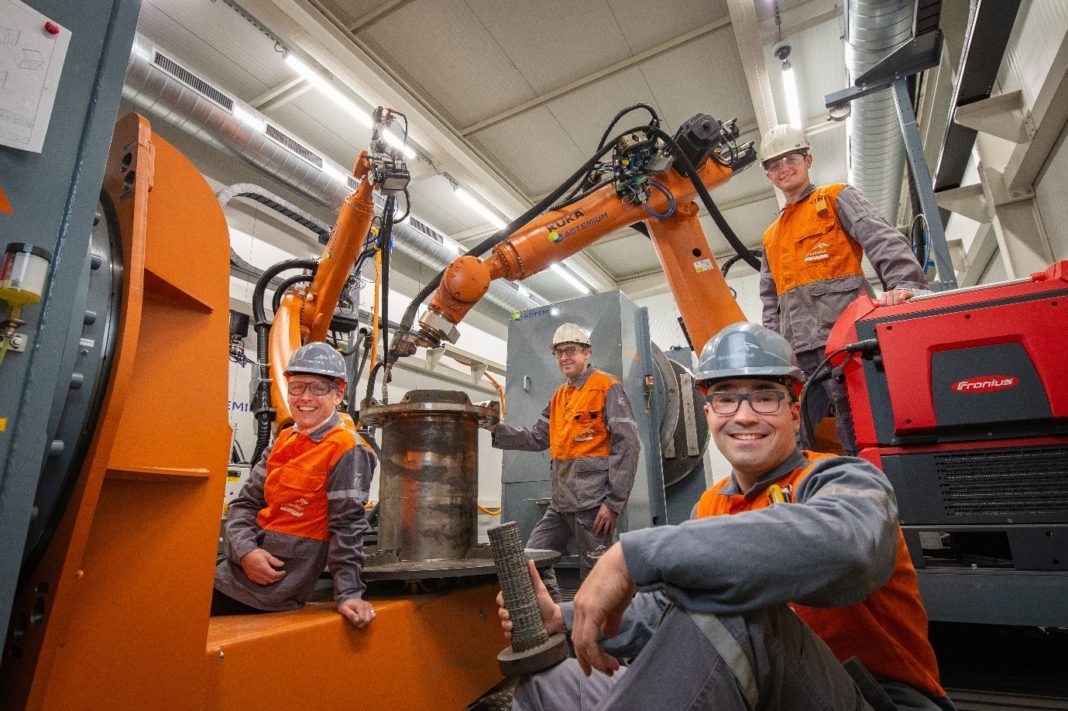Once you have decided to go down the Metal Additive Manufacturing (AM) route, the next step is at least equally important. While “value for money” is often the most analysed criterion, the truth is, working with a solutions provider must go beyond this important argument. Indeed, not only is the market filled with companies offering AM services, but also confusion can quickly arise when one realizes there is also a wide range of metal AM technologies. What criteria should you use to favour one technology over another? And most importantly, how should/do you envision the future of your production with that Metal AM solution?
Over the last years, Metal AM has gradually seen a shift from prototyping towards mainstream production technology for several industries such as medical, aerospace and automotive.
Widespread industry adoption has however been focussed on relatively small sized components as the production of large sized metal parts wasn’t technically possible or economically attractive using powder-based processes.
Size does matter!
The intrinsic benefits of AM (small lot sizes, inventory reduction, obsolescence management, etc.) are particularly appealing for large sized metal components used in industries such as oil & gas, maritime, energy, transport, mining, aerospace, or heavy industry. These industries often use castings or forgings which, depending on the environment they are used in, could be made of carbon or stainless steel, nickel-based alloys or even titanium. The fact is, the more complex the geometry becomes, the more the casting or forging process itself results in significant material waste, but also suffers from extended lead times and non-negligible failure rates.
All of these constraints often lead manufacturers to explore manufacturing processes which could best meet these requirements.
“The combination of component size and functional complexity makes a compelling case for the wire based DED-processes (CMT and plasma) offered as a one-stop-shop manufacturing service by Guaranteed as it allows parts up to 10 x 5 x 6 meters and up to 20 tons to be produced near-net-shape within short lead times at a competitive cost. Currently the material database is already well populated (steel, stainless, Inconel, titanium, aluminium, bronze …), but it can easily be expanded at the request of our customers”, Joachim Antonissen, CEO Guaranteed comments.
From a cost standpoint, it should be noted that there is a wide choice of commercially available welding wires, which come at a considerably lower cost compared to their powder counterparts. Added to this, the fact that quasi 100% dense parts are produced, omitting the need for hipping, makes wire-based processes such as WAAM an interesting choice from an economic point of view.
As Guaranteed’s technologies allow a hybrid approach by depositing on top of an existing component (e.g. plate or cylinder) or even to repair an existing part, the business case is further improved even without taking into account logistic savings such as reduced lead times or stock keeping costs. Beside the resulting economic benefits, localized repair or on-demand near net shape production also contributes to sustainability as it significantly reduces the need for raw materials and transport.
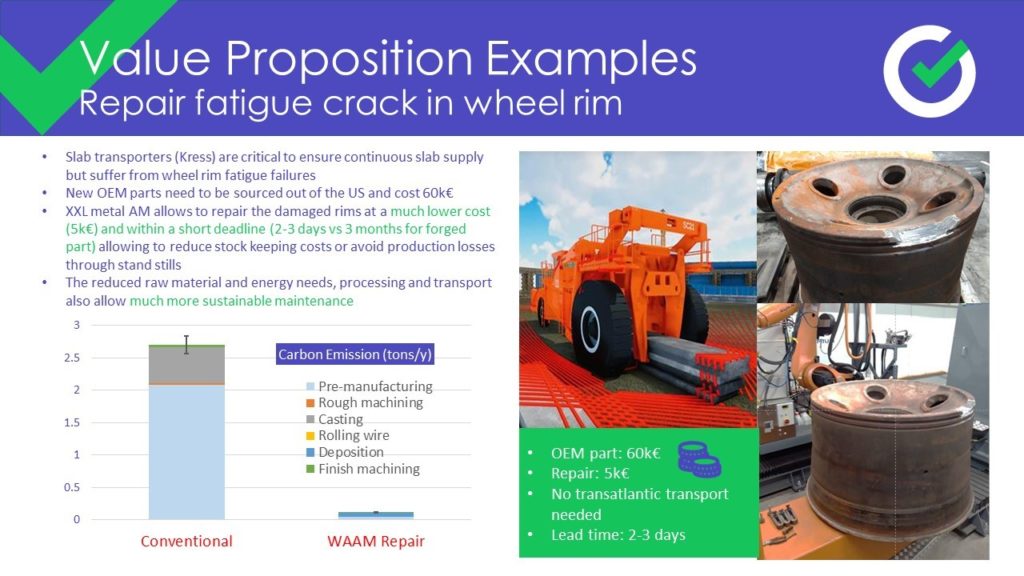 Cost is important, quality is the best way to reduce it
Cost is important, quality is the best way to reduce it
Unlike most situations where “premium quality” is synonym of “expensive cost”, in this case, cost and quality are not conflicting but rather reinforce each other. Pursuing high quality is ultimately the best way to reduce costs. Indeed, when switching from Conventional Manufacturing (CM) to Additive Manufacturing (AM), the certification requirements imposed by the part’s severe operating conditions obviously need to be considered when assessing the business case.
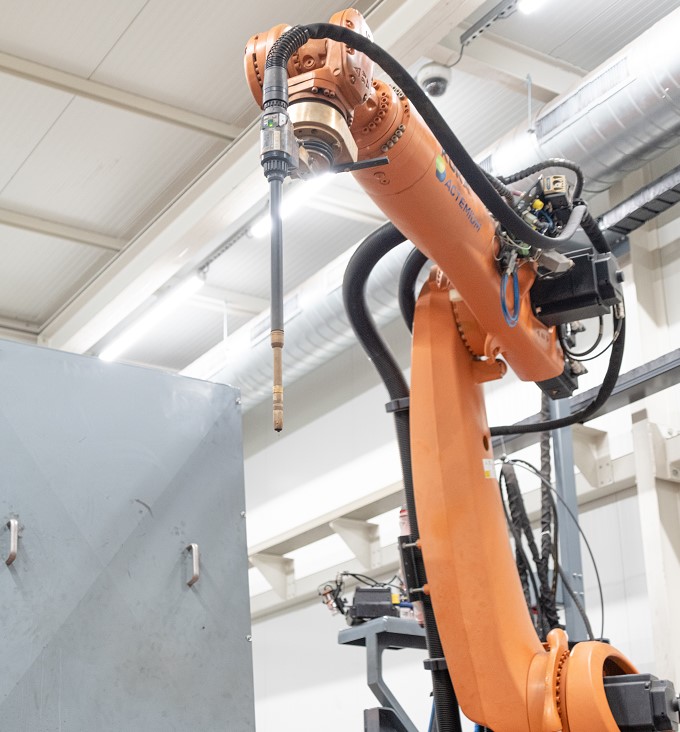
Depending on the criticality level of the component, certification might impose a substantial amount of destructive test samples to be produced alongside the actual part. Through its process control software, Guaranteed is able to ensure part performance which significantly reduces the number of expensive trial-and-error loops. Being involved in various collaborative projects aiming at establishing clear certification guidelines for the use of AM in oil & gas, maritime, rail and mining industries, Guaranteed is driving this further to turn certification into an inherent part of its quality assurance framework. Process qualification, rather than single part qualification, will broaden the portfolio of AM parts and components, to achieve faster qualification and/or certification than nowadays. In close partnership with leading universities, Guaranteed is developing the next generation of WAAM technology. The latter will allow deposition speeds to be increased even further without compromising on quality while dynamic mechanical properties will be enhanced beyond those of forged material by in-process microstructural manipulation technologies.
“Born from innovation, we use state of the art unique simulation, monitoring and inspection tools to guarantee first time right zero-defect production. Being raised in Industry, we guarantee one-stop-shop industrial reliability”, Sander Plasschaert, CTO Guaranteed states.
Is the best spare part a virtual one?
As installations operate in increasingly challenging environments, there is a larger likelihood of essential parts breaking down, becoming obsolete due to technological changes or changes to standards or going out of production before their end of life. The small series sizes and short life cycles of parts relative to the installations present a challenge in inventory management and further strengthen the case for the deployment of large size metal AM.
Traditional production technologies make it too costly and require too much time to produce parts on demand. The result is a significant amount of inventory of infrequently ordered parts. This inventory ties up capital for products that are unused. They occupy physical space, buildings, and land while requiring rent, utility costs, insurance, and taxes. Meanwhile the products are deteriorating and becoming obsolete. Being able to produce these parts on demand using AM reduces the need for maintaining large inventory and eliminates the associated costs while leading to greater asset longevity.
In an automotive assembly line, for example, only 8% of each euro invested is spent in actual assembly. Each individual component is produced separately and has inventories of its own, while all parts also need to be transported. Studies have shown that up to 10% of a manufacturing company’s revenue is tied up in inventories. The resources spent producing and storing these parts could be used elsewhere if the need for inventory were reduced.
Today, Guaranteed is already actively participating to digital warehouse eco-systems in sectors such as oil & gas, railways and maritime industry.
“AM supports our operations with shorter lead-time because it creates a shift towards buying parts just-in-time as opposed to just-in-case. The traditional way of buying spare parts at the onset of installing new equipment, may no longer be necessary if we can print the parts with the same or improved quality. Spare parts stored in a warehouse require proper storage and preservation which comes at a cost and does not provide agility when operating conditions change and the original spare parts may no longer be suitable. We believe that printing spare parts just-in-time eventually reduces the costs of sourcing specific parts, especially those that are critical for business operations”, A. Goh, Shell points out.
Value the future, upgrade the past
Ageing installations are a common issue in many industries. Assets are increasingly used beyond their original design life, which results in parts becoming high-risk for downtime or failure. This can result in significant non-productive time which could cost upwards of hundreds of thousands of euros annually. Maintaining the integrity of equipment is difficult given that like-for-like replacements of parts are no longer available due to obsolescence of the equipment model or changes in engineering standards.
Guaranteed’s on-demand WAAM services allow such parts to be reproduced at an affordable cost, even for lot size one, repaired or refurbished. In the latter case, the original part design or material selection is given an upgrade which allows the refurbished part to have an increased performance or life time as compared to the original OEM part.
For very large parts or failures occurring in remote areas, the costs and logistics involved in dismantling and transporting the damaged part might become prohibitive. To resolve this issue, Guaranteed developed a “mobile WAAM additive repair service” which allows on-site or even in-situ repair or remanufacturing to be achieved.
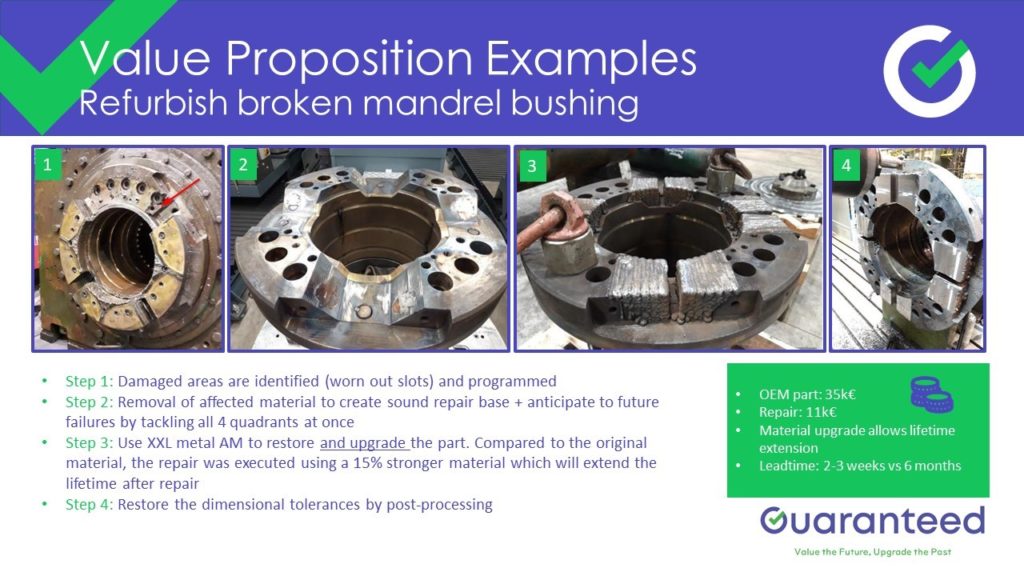 Less is more
Less is more
With climate change as the central challenge of the 21st century, resource efficiency and reducing the carbon footprint have become vital challenges for today’s manufacturing industry. Localized production to decrease transportation efforts and manufacturing products on demand to directly lower waste and avoid scrapping excess parts will eventually become necessities to avoid taxation or institutional penalties. Additionally, the demand to refurbish machines and products to extend their lifetime will continue to grow.
“AM and digital parts libraries will result in cost savings through smaller inventory volumes and reducing costs and risks of late life and obsolescence. As Equinor moves to zero carbon and increases its renewables presence, reducing the environmental impact of equipment production and the transport of parts through the supply chain will become increasingly important”, Brede Laerum – Equinor adds.
In a recent study which has been performed by Guaranteed in close collaboration with the University of Cranfield and its spin-off company WAAM3D, a comparative life cycle analysis was made for several parts. As compared to conventional manufacturing options such as casting or forging, the results of this study clearly demonstrate the significant savings which can be achieved in terms of carbon emissions and energy consumption for WAAM production and even more so for WAAM repair or refurbishment.
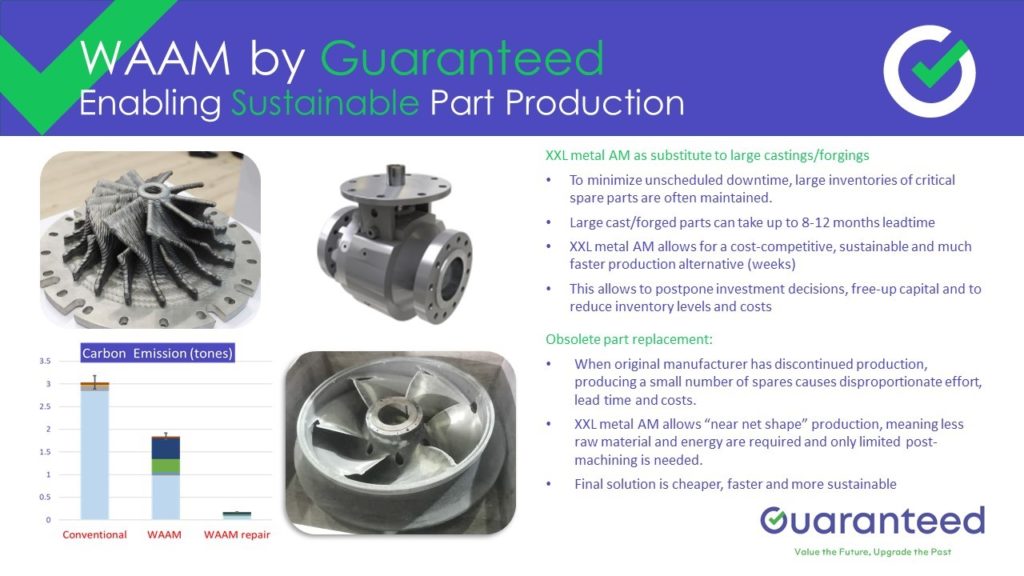 The sustainable character of our technology already provides Guaranteed access to funding from the booster fund of the European Institute of Technology which invests in companies that realize sustainability and reshore work to Europe.
The sustainable character of our technology already provides Guaranteed access to funding from the booster fund of the European Institute of Technology which invests in companies that realize sustainability and reshore work to Europe.
Proof, not promises
As the proof of the pudding is in the eating, Guaranteed works in full transparency and close collaboration with its customers worldwide to analyse, optimise and share the learnings in each business case.

For some of our customers this means that we will recommend considering repair or refurbishment rather than complete remanufacturing while for others the benefits of on demand spare part production will allow reducing warehousing costs and generate a direct impact on profitability as working capital requirements will be lowered resulting in additional cash flow. Mitigating obsolescence issues either directly in ageing production equipment or indirectly in inventories by just-in-time manufacturing represents yet another way the services provided by Guaranteed can create value.
Last but not least, the resource efficiency and CO2 emission savings resulting from working with Guaranteed provide a pathway to a more sustainable future by reducing the amount of primary and secondary emissions.
This content has been created in collaboration with Guaranteed.
Initially published in the 2021 September/October edition of 3D ADEPT Mag.
Contact details:
All images: courtesy of Guaranteed
+32 473 30 19 28 | info@guaranteed.be


